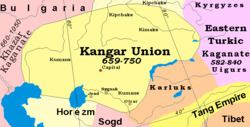Languages Old Turkic Political structure Federation Established 659 | Religion Tengriism | |
 | ||
Capital located in Ulutau mountains | ||
Kangar union, Kazakh: Қaңғar Odaғy (Kanghar Odaghü) was a Turkic state in the territory of the entire modern Kazakhstan without Zhetysu. The ethnic name Kangar is a medieval name for the Kangly people, who are now part of the Kazakh, Uzbek, and Karakalpak nations. The Kangly (Qangly, Kang, Kangar, Kengeres, Kangdy, Kangarlyk, Kankalis) were a Turkic tribe known from the 2nd century BCE to past the 12th century CE. The Western Branch of Kangars after a defeat from Kypchaks of the Kimek Kaganate attacked and defeated the Bulgars, establishing the Kangar state in Eastern Europe (840-990 CE). The capital of the Kangar union was located in the Ulytau mountains.
Contents
Etymology
A modern interpretation of the etymology is that ethnonym Kangar consists of two roots, Kang/Kang (Qang/Qang), a Turkic for "father, primogenitor", and ar "people, men",Kanger. An alternate etymology is that the word kangly in Old Turkic meant "wagon, vehicle", and is homonymous with the name of the Kangly tribe.
Kengeres' of the Orkhon inscriptions were known in the Islamic world and in the west as Bajanaks (Lat. Besenyo, Turcic Pechenek, Pechenegs) whose self-designation was Kangar. Constantine Porphyrogenitus wrote that "Kangar" meant nobleness and bravery.
Independence
After the capture of Zhetysu by the Chinese, Kangars become independent from the Turkic Kaganate. They repulsed Chinese from the southern Kazakhstan and Syr Darya cities. The Syr Darya cities retained their autonomy. The Oguzes in the southern Kazakhstan, Kimaks in the Irtysh River valley, Cumans in Mugodjar, and Kypchaks in the northern Kazakhstan became the vassals of the Kangar union.
At the end of the 7th century the Syr Darya cities rebelled and formed an alliance with the Sogdiana. The revolt was successful, but the Moslem Arab armies attacked Sogdiana from the south. The revolt has waned, and Kangars consented to the continued autonomy of the Syr Darya cities.
Fall of the Union
At the beginning of the 8th century the Oghuz confederation and the city of Tashkent seceded from the Kangar union. The Arabs continued raiding Sygnakh, Khojent (Jend, Jent), Iași, and other rich Kangar cities.
After the Arabs captured Sogdiana, they attacked the Kangar cities along the Syr Darya. The Arabs captured the southern Kazakhstan, and the Oguz confederation took control over the other Kangar cities along the Syr Darya. The Oguzes formed an alliance with the Kimak Kaganate. The Kangar Union dissolved. The western branch of the Kangars, known in the west under the name of their allied tribe of Pechenegs, captured the lands of the Khazar Kaganate, and created a Kangar successor state in the Eastern Europe.
Kangar migration and North Pontic Kangar state
A mass migration of the Oghuz tribes in the middle of the 8th c. displaced population of the Kangar Union on the eastern borders of the Khazar Kaganate, forcing it to move into Khazarian territories. At first, Kangars settled in the territory between Yaik-Emba (Geeh) and Itil (Volga) rivers, then they advanced into the Khazar domain territories. The forceful influx of Kangars and their allied tribes seriously impacted Khazar populations with destruction of settlements and population, and the population mass escape to safer areas to the north and south, and the Magyars of Lebedia to the west. The Kangar tribal Union, better known in Europe as Pechenegs under a Slavic name of their subject allies, occupied a large swath of Khazaria extending from Don in the east to Pannonia in the west. Between the rivers Yaik and Emba, they controlled the Khazar trading route from Itil to Khorezm, dealing a hard blow to the Khazarian trade. The North Pontic Kangar state eventually established coexistent with Khazaria, while dominating North Pontic area of Khazaria from ca. 750 to ca. 900. Constantine Porphyrogenitus named three Kangar tribes (Chor (Charvat), Ertim, Yula), and four Bechen tribes (Kapan, Karabai, Kulbei, Tolmach), and their respective locations. Gardizi (ca. 1050) reported on the situation around 950: "Bechens are nomads following rain and pasturage. Their territory extends a distance of thirty days in either direction (i.e. about 1,000x1,000 km), bordering Kipchaks in the north, Khazars on southwest, Oguz in the east, and Saqlabs (bilad as-Saqaliba, Bulgars) to the west. All these peoples raid Bechens, who likewise raid them...". At the end, Kangars were displaced further west by the migration of the Kipchak tribes, who ca. 990 embarked on a massive migration into the E.Europe, supplanting Kangars-Bosnyaks in the east of the Kangar North Pontic state.
